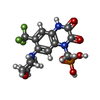+ Open data
Open data
- Basic information
Basic information
| Entry | Database: PDB / ID: 5vhy | ||||||
|---|---|---|---|---|---|---|---|
| Title | GluA2-2xGSG1L bound to ZK | ||||||
 Components Components | Glutamate receptor 2,Germ cell-specific gene 1-like protein | ||||||
 Keywords Keywords |  TRANSPORT PROTEIN / TRANSPORT PROTEIN /  Ion channel Ion channel | ||||||
| Function / homology |  Function and homology information Function and homology information regulation of postsynaptic neurotransmitter receptor activity / regulation of postsynaptic neurotransmitter receptor activity /  regulation of AMPA receptor activity / regulation of postsynaptic neurotransmitter receptor internalization / spine synapse / dendritic spine neck / dendritic spine head / Activation of AMPA receptors / response to lithium ion / cellular response to glycine / perisynaptic space ... regulation of AMPA receptor activity / regulation of postsynaptic neurotransmitter receptor internalization / spine synapse / dendritic spine neck / dendritic spine head / Activation of AMPA receptors / response to lithium ion / cellular response to glycine / perisynaptic space ... regulation of postsynaptic neurotransmitter receptor activity / regulation of postsynaptic neurotransmitter receptor activity /  regulation of AMPA receptor activity / regulation of postsynaptic neurotransmitter receptor internalization / spine synapse / dendritic spine neck / dendritic spine head / Activation of AMPA receptors / response to lithium ion / cellular response to glycine / perisynaptic space / AMPA glutamate receptor activity / Trafficking of GluR2-containing AMPA receptors / regulation of AMPA receptor activity / regulation of postsynaptic neurotransmitter receptor internalization / spine synapse / dendritic spine neck / dendritic spine head / Activation of AMPA receptors / response to lithium ion / cellular response to glycine / perisynaptic space / AMPA glutamate receptor activity / Trafficking of GluR2-containing AMPA receptors /  immunoglobulin binding / AMPA glutamate receptor complex / kainate selective glutamate receptor activity / immunoglobulin binding / AMPA glutamate receptor complex / kainate selective glutamate receptor activity /  ionotropic glutamate receptor complex / extracellularly glutamate-gated ion channel activity / asymmetric synapse / regulation of receptor recycling / Unblocking of NMDA receptors, glutamate binding and activation / ionotropic glutamate receptor complex / extracellularly glutamate-gated ion channel activity / asymmetric synapse / regulation of receptor recycling / Unblocking of NMDA receptors, glutamate binding and activation /  glutamate receptor binding / positive regulation of synaptic transmission / presynaptic active zone membrane / response to fungicide / glutamate-gated receptor activity / glutamate receptor binding / positive regulation of synaptic transmission / presynaptic active zone membrane / response to fungicide / glutamate-gated receptor activity /  regulation of synaptic transmission, glutamatergic / cellular response to brain-derived neurotrophic factor stimulus / somatodendritic compartment / dendrite membrane / ligand-gated monoatomic ion channel activity involved in regulation of presynaptic membrane potential / regulation of synaptic transmission, glutamatergic / cellular response to brain-derived neurotrophic factor stimulus / somatodendritic compartment / dendrite membrane / ligand-gated monoatomic ion channel activity involved in regulation of presynaptic membrane potential /  ionotropic glutamate receptor binding / ionotropic glutamate receptor binding /  cytoskeletal protein binding / ionotropic glutamate receptor signaling pathway / dendrite cytoplasm / cytoskeletal protein binding / ionotropic glutamate receptor signaling pathway / dendrite cytoplasm /  SNARE binding / dendritic shaft / transmitter-gated monoatomic ion channel activity involved in regulation of postsynaptic membrane potential / SNARE binding / dendritic shaft / transmitter-gated monoatomic ion channel activity involved in regulation of postsynaptic membrane potential /  synaptic membrane / synaptic membrane /  synaptic transmission, glutamatergic / synaptic transmission, glutamatergic /  PDZ domain binding / postsynaptic density membrane / protein tetramerization / modulation of chemical synaptic transmission / Schaffer collateral - CA1 synapse / establishment of protein localization / PDZ domain binding / postsynaptic density membrane / protein tetramerization / modulation of chemical synaptic transmission / Schaffer collateral - CA1 synapse / establishment of protein localization /  terminal bouton / terminal bouton /  receptor internalization / synaptic vesicle membrane / cerebral cortex development / receptor internalization / synaptic vesicle membrane / cerebral cortex development /  synaptic vesicle / presynapse / synaptic vesicle / presynapse /  signaling receptor activity / signaling receptor activity /  presynaptic membrane / presynaptic membrane /  amyloid-beta binding / amyloid-beta binding /  growth cone / chemical synaptic transmission / growth cone / chemical synaptic transmission /  perikaryon / perikaryon /  postsynaptic membrane / postsynaptic membrane /  scaffold protein binding / scaffold protein binding /  dendritic spine / dendritic spine /  postsynaptic density / neuron projection / postsynaptic density / neuron projection /  axon / neuronal cell body / axon / neuronal cell body /  dendrite / glutamatergic synapse / dendrite / glutamatergic synapse /  synapse / protein-containing complex binding / endoplasmic reticulum membrane / synapse / protein-containing complex binding / endoplasmic reticulum membrane /  protein kinase binding / protein kinase binding /  cell surface / cell surface /  endoplasmic reticulum / protein-containing complex / endoplasmic reticulum / protein-containing complex /  membrane / identical protein binding / membrane / identical protein binding /  plasma membrane plasma membraneSimilarity search - Function | ||||||
| Biological species |   Rattus norvegicus (Norway rat) Rattus norvegicus (Norway rat) | ||||||
| Method |  ELECTRON MICROSCOPY / ELECTRON MICROSCOPY /  single particle reconstruction / single particle reconstruction /  cryo EM / Resolution: 4.6 Å cryo EM / Resolution: 4.6 Å | ||||||
 Authors Authors | Twomey, E.C. / Yelshanskaya, M.V. / Grassucci, R.A. / Frank, J. / Sobolevsky, A.I. | ||||||
 Citation Citation |  Journal: Neuron / Year: 2017 Journal: Neuron / Year: 2017Title: Structural Bases of Desensitization in AMPA Receptor-Auxiliary Subunit Complexes. Authors: Edward C Twomey / Maria V Yelshanskaya / Robert A Grassucci / Joachim Frank / Alexander I Sobolevsky /  Abstract: Fast excitatory neurotransmission is mediated by AMPA-subtype ionotropic glutamate receptors (AMPARs). AMPARs, localized at post-synaptic densities, are regulated by transmembrane auxiliary subunits ...Fast excitatory neurotransmission is mediated by AMPA-subtype ionotropic glutamate receptors (AMPARs). AMPARs, localized at post-synaptic densities, are regulated by transmembrane auxiliary subunits that modulate AMPAR assembly, trafficking, gating, and pharmacology. Aberrancies in AMPAR-mediated signaling are associated with numerous neurological disorders. Here, we report cryo-EM structures of an AMPAR in complex with the auxiliary subunit GSG1L in the closed and desensitized states. GSG1L favors the AMPAR desensitized state, where channel closure is facilitated by profound structural rearrangements in the AMPAR extracellular domain, with ligand-binding domain dimers losing their local 2-fold rotational symmetry. Our structural and functional experiments suggest that AMPAR auxiliary subunits share a modular architecture and use a common transmembrane scaffold for distinct extracellular modules to differentially regulate AMPAR gating. By comparing the AMPAR-GSG1L complex structures, we map conformational changes accompanying AMPAR recovery from desensitization and reveal structural bases for regulation of synaptic transmission by auxiliary subunits. | ||||||
| History |
|
- Structure visualization
Structure visualization
| Movie |
 Movie viewer Movie viewer |
|---|---|
| Structure viewer | Molecule:  Molmil Molmil Jmol/JSmol Jmol/JSmol |
- Downloads & links
Downloads & links
- Download
Download
| PDBx/mmCIF format |  5vhy.cif.gz 5vhy.cif.gz | 709.1 KB | Display |  PDBx/mmCIF format PDBx/mmCIF format |
|---|---|---|---|---|
| PDB format |  pdb5vhy.ent.gz pdb5vhy.ent.gz | 552.7 KB | Display |  PDB format PDB format |
| PDBx/mmJSON format |  5vhy.json.gz 5vhy.json.gz | Tree view |  PDBx/mmJSON format PDBx/mmJSON format | |
| Others |  Other downloads Other downloads |
-Validation report
| Arichive directory |  https://data.pdbj.org/pub/pdb/validation_reports/vh/5vhy https://data.pdbj.org/pub/pdb/validation_reports/vh/5vhy ftp://data.pdbj.org/pub/pdb/validation_reports/vh/5vhy ftp://data.pdbj.org/pub/pdb/validation_reports/vh/5vhy | HTTPS FTP |
|---|
-Related structure data
| Related structure data |  8687MC  8685C  8686C  8688C  5vhwC  5vhxC  5vhzC M: map data used to model this data C: citing same article ( |
|---|---|
| Similar structure data |
- Links
Links
- Assembly
Assembly
| Deposited unit | 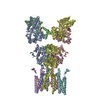
|
|---|---|
| 1 |
|
- Components
Components
| #1: Protein | Mass: 117471.211 Da / Num. of mol.: 6 Source method: isolated from a genetically manipulated source Source: (gene. exp.)   Rattus norvegicus (Norway rat) / Gene: Gria2, Glur2, Gsg1l / Cell line (production host): HEK-293S / Production host: Rattus norvegicus (Norway rat) / Gene: Gria2, Glur2, Gsg1l / Cell line (production host): HEK-293S / Production host:   Homo sapiens (human) / References: UniProt: P19491, UniProt: D3ZK93 Homo sapiens (human) / References: UniProt: P19491, UniProt: D3ZK93#2: Chemical | ChemComp-ZK1 / {[  Fanapanel Fanapanel#3: Sugar | ChemComp-NAG /  N-Acetylglucosamine N-Acetylglucosamine |
|---|
-Experimental details
-Experiment
| Experiment | Method:  ELECTRON MICROSCOPY ELECTRON MICROSCOPY |
|---|---|
| EM experiment | Aggregation state: PARTICLE / 3D reconstruction method:  single particle reconstruction single particle reconstruction |
- Sample preparation
Sample preparation
| Component | Name: GluA2-2xGSG1L ZK cryo-EM density / Type: COMPLEX / Entity ID: all / Source: RECOMBINANT |
|---|---|
| Molecular weight | Experimental value: NO |
| Source (natural) | Organism:   Rattus norvegicus (Norway rat) Rattus norvegicus (Norway rat) |
| Source (recombinant) | Organism:   Rattus norvegicus (Norway rat) Rattus norvegicus (Norway rat) |
| Buffer solution | pH: 8 |
| Specimen | Conc.: 5 mg/ml / Embedding applied: NO / Shadowing applied: NO / Staining applied : NO / Vitrification applied : NO / Vitrification applied : YES : YES |
| Specimen support | Details: Gold-gold grids, hydrogen and oxygen glow discharge (20s, 10 watts, 6.4 sccm H2, 27.5 sccm O2) Grid material: GOLD / Grid mesh size: 200 divisions/in. / Grid type: C-flat-1.2/1.3 |
Vitrification | Instrument: FEI VITROBOT MARK IV / Cryogen name: ETHANE / Humidity: 100 % / Chamber temperature: 295 K |
- Electron microscopy imaging
Electron microscopy imaging
| Experimental equipment |  Model: Titan Krios / Image courtesy: FEI Company |
|---|---|
| Microscopy | Model: FEI TITAN KRIOS |
| Electron gun | Electron source : :  FIELD EMISSION GUN / Accelerating voltage: 300 kV / Illumination mode: SPOT SCAN FIELD EMISSION GUN / Accelerating voltage: 300 kV / Illumination mode: SPOT SCAN |
| Electron lens | Mode: BRIGHT FIELD Bright-field microscopy Bright-field microscopy |
| Image recording | Electron dose: 80 e/Å2 / Detector mode: SUPER-RESOLUTION / Film or detector model: GATAN K2 SUMMIT (4k x 4k) |
- Processing
Processing
CTF correction | Type: PHASE FLIPPING AND AMPLITUDE CORRECTION |
|---|---|
| Symmetry | Point symmetry : C2 (2 fold cyclic : C2 (2 fold cyclic ) ) |
3D reconstruction | Resolution: 4.6 Å / Resolution method: FSC 0.143 CUT-OFF / Num. of particles: 42637 / Symmetry type: POINT |
 Movie
Movie Controller
Controller



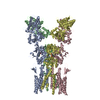
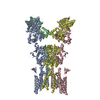
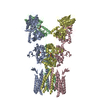
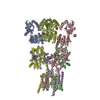

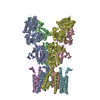
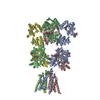
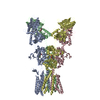
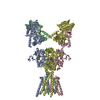
 PDBj
PDBj




